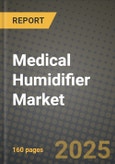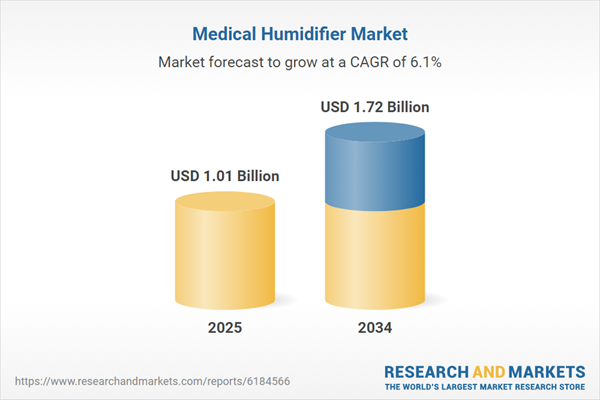Medical Humidifier Market
Medical humidifiers condition respiratory gases to physiologic humidity and temperature to protect airway mucosa, maintain mucociliary function, and improve patient comfort across invasive ventilation, non-invasive ventilation (NIV), high-flow nasal cannula (HFNC), anesthesia, neonatal care, oxygen therapy, and home sleep/respiratory support. The product landscape spans active heated humidifiers with heated-wire circuits and servo control; passive heat-and-moisture exchangers (HMEs) for short-term or transport; bubble and pass-over systems for oxygen therapy; integrated humidifiers within ventilators and PAP devices; and single-use circuits, chambers, and filters designed for infection control. Key trends include rapid adoption of HFNC in acute and step-down settings, closed-loop humidity delivery tied to patient and environmental sensors, intuitive UIs with alarm rationalization, and sterile water logistics that lower contamination risk. Hospitals pursue fleet standardization, disposable conversion for infection prevention, and interoperability with ventilators, anesthesia workstations, and hospital IT. Homecare growth reflects aging populations and adherence-focused PAP and oxygen platforms with compact integrated humidifiers and anti-condensation algorithms. Procurement emphasizes thermal performance at patient connection, condensate (“rain-out”) mitigation, chamber endurance, noise, and total cost per therapy hour - including water, circuits, and energy. Competitive dynamics feature respiratory majors, anesthesia/ventilation OEMs, and specialized humidification players, with differentiation in humidity stability under fluctuating flows, neonatal precision, and humidification at high altitude or extreme ambient conditions. Operationally, resilient supply of sterile water, chambers, and circuits, along with sustainability initiatives (recyclable components, reduced energy draw), influence long-term vendor selection and contracting.Medical Humidifier Market Key Insights
- Use-case segmentation is widening. ICUs require precise, stable humidification for invasive ventilation; wards and EDs expand HFNC; homecare centers on PAP and NIV comfort - each with distinct chamber sizes, control algorithms, and accessories.
- Closed-loop accuracy wins tenders. Systems that measure at-patient temperature/humidity and auto-adjust to ambient changes reduce drying, secretions, and rainout, improving tolerance and reducing alarms and circuit breaks.
- Condensation control is a core differentiator. Heated-wire circuits, smart temperature gradients, and water trap designs cut rainout, lower contamination risk, and reduce nursing workload in high-flow and NIV applications.
- Infection-prevention drives disposables. Single-patient chambers, sterile water pathways, and integrated bacteria/viral filtration in HMEFs address cross-contamination concerns where reprocessing capacity is variable.
- Energy and water stewardship matter. Low-power heaters, insulated circuits, and optimized warm-up profiles meet hospital sustainability goals while protecting dew-point stability in cool rooms.
- Human factors determine adherence. Intuitive knobs/UI, guided setup, and quiet operation boost patient comfort and staff confidence; home PAP users value easy-fill reservoirs and spill-safe designs.
- Interoperability reduces total cost. Broad compatibility with ventilators, HFNC drivers, and anesthesia machines, plus standard probes and connectors, simplifies inventory and training across mixed fleets.
- Data and QA are emerging moats. Event logging, consumable life tracking, and fleet dashboards support audits, reduce misuse, and standardize protocols across multi-site networks.
- HME vs. active humidification is contextual. HME/HMEF suits short, stable cases; active heated systems prevail in prolonged ventilation, thick secretions, or high flows where moisture balance is critical.
- Home and post-acute care are growth lanes. Supported by remote coaching and supplies logistics, integrated PAP humidifiers and compact NIV/HFNC units extend humidification benefits beyond hospital walls.
Medical Humidifier Market Reginal Analysis
North America
Adoption is driven by HFNC standardization in acute care, large PAP/NIV homecare populations, and strong infection-prevention programs. Hospitals specify closed-loop heated systems with rainout mitigation and data logs for quality teams. Group purchasing and value-analysis committees weigh lifecycle cost of disposables versus reusables; home channels favor spill-safe reservoirs, quiet operation, and reliable supply of chambers and sterile water. Service coverage and training libraries influence multi-state IDN awards.Europe
Procurement emphasizes documented performance, ergonomic design, and sustainability. Public tenders scrutinize energy profiles, recyclability of components, and validated cleaning workflows for reusable chambers where central sterile capacity is robust. HFNC is entrenched in respiratory wards; anesthesia departments seek compact, integrated options with clear UI. Homecare contracts require adherence support and standardized consumables across PAP device brands.Asia-Pacific
High procedure volumes and expanding critical-care capacity underpin demand for ICU-grade heated systems and cost-effective HMEFs. Japan and Australia prioritize meticulous dew-point control and condensation management; China and India scale HFNC in tertiary hospitals and broaden PAP adoption in sleep clinics. Local manufacturing and distribution depth are important for sterile water and chamber availability; bilingual interfaces and training assets speed uptake.Middle East & Africa
Growth tracks investments in tertiary hospitals, government respiratory programs, and private networks. Hot climates and variable ambient conditions elevate the value of robust closed-loop control and insulated circuits to prevent rainout in cool, air-conditioned rooms. Import reliance makes distributor service, spare-part stocking, and clinician training central; standardized kits simplify deployment across new facilities.South & Central America
Urban reference hospitals expand HFNC and NIV, favoring durable heaters and easy-to-manage chambers; HMEFs see strong use in perioperative and transport settings. Budget variability drives a mix of disposable and reusable strategies; local partners that ensure steady consumable supply win share. Home PAP humidification adoption grows with sleep-medicine awareness, supported by patient education and simple maintenance routines.Medical Humidifier Market Segmentation
By Capacity
- Heated Humidifiers
- Heat & Moisture Exchangers
- Bubble Humidifiers
- Humidifier Accessories
By Application
- Intensive Care Units
- Neonatal Care
- Respiratory Therapy
- Others
- Distribution Channel
- Hospital Pharmacies
- Retail Pharmacies
- Online Pharmacies
By Patient
- Adult Patients
- Neonatal Patients
- Pediatric Patients
By End-User
- Hospitals & Ambulatory Surgery Centers
- Home Care Settings
- Specialty Clinics
- Others
Key Market players
Fisher & Paykel Healthcare, Teleflex Incorporated, Philips Respironics, ResMed Inc., Smiths Medical, Armstrong Medical, Becton Dickinson, DeVilbiss Healthcare, Vapotherm, Drive DeVilbiss, Hamilton Medical, PARI GmbH, Medtronic plc, Draegerwerk AG, Westmed Inc.Medical Humidifier Market Analytics
The report employs rigorous tools, including Porter’s Five Forces, value chain mapping, and scenario-based modelling, to assess supply-demand dynamics. Cross-sector influences from parent, derived, and substitute markets are evaluated to identify risks and opportunities. Trade and pricing analytics provide an up-to-date view of international flows, including leading exporters, importers, and regional price trends.Macroeconomic indicators, policy frameworks such as carbon pricing and energy security strategies, and evolving consumer behaviour are considered in forecasting scenarios. Recent deal flows, partnerships, and technology innovations are incorporated to assess their impact on future market performance.
Medical Humidifier Market Competitive Intelligence
The competitive landscape is mapped through proprietary frameworks, profiling leading companies with details on business models, product portfolios, financial performance, and strategic initiatives. Key developments such as mergers & acquisitions, technology collaborations, investment inflows, and regional expansions are analyzed for their competitive impact. The report also identifies emerging players and innovative startups contributing to market disruption.Regional insights highlight the most promising investment destinations, regulatory landscapes, and evolving partnerships across energy and industrial corridors.
Countries Covered
- North America - Medical Humidifier market data and outlook to 2034
- United States
- Canada
- Mexico
- Europe - Medical Humidifier market data and outlook to 2034
- Germany
- United Kingdom
- France
- Italy
- Spain
- BeNeLux
- Russia
- Sweden
- Asia-Pacific - Medical Humidifier market data and outlook to 2034
- China
- Japan
- India
- South Korea
- Australia
- Indonesia
- Malaysia
- Vietnam
- Middle East and Africa - Medical Humidifier market data and outlook to 2034
- Saudi Arabia
- South Africa
- Iran
- UAE
- Egypt
- South and Central America - Medical Humidifier market data and outlook to 2034
- Brazil
- Argentina
- Chile
- Peru
Research Methodology
This study combines primary inputs from industry experts across the Medical Humidifier value chain with secondary data from associations, government publications, trade databases, and company disclosures. Proprietary modeling techniques, including data triangulation, statistical correlation, and scenario planning, are applied to deliver reliable market sizing and forecasting.Key Questions Addressed
- What is the current and forecast market size of the Medical Humidifier industry at global, regional, and country levels?
- Which types, applications, and technologies present the highest growth potential?
- How are supply chains adapting to geopolitical and economic shocks?
- What role do policy frameworks, trade flows, and sustainability targets play in shaping demand?
- Who are the leading players, and how are their strategies evolving in the face of global uncertainty?
- Which regional “hotspots” and customer segments will outpace the market, and what go-to-market and partnership models best support entry and expansion?
- Where are the most investable opportunities - across technology roadmaps, sustainability-linked innovation, and M&A - and what is the best segment to invest over the next 3-5 years?
Your Key Takeaways from the Medical Humidifier Market Report
- Global Medical Humidifier market size and growth projections (CAGR), 2024-2034
- Impact of Russia-Ukraine, Israel-Palestine, and Hamas conflicts on Medical Humidifier trade, costs, and supply chains
- Medical Humidifier market size, share, and outlook across 5 regions and 27 countries, 2023-2034
- Medical Humidifier market size, CAGR, and market share of key products, applications, and end-user verticals, 2023-2034
- Short- and long-term Medical Humidifier market trends, drivers, restraints, and opportunities
- Porter’s Five Forces analysis, technological developments, and Medical Humidifier supply chain analysis
- Medical Humidifier trade analysis, Medical Humidifier market price analysis, and Medical Humidifier supply/demand dynamics
- Profiles of 5 leading companies - overview, key strategies, financials, and products
- Latest Medical Humidifier market news and developments
Additional Support
With the purchase of this report, you will receive:- An updated PDF report and an MS Excel data workbook containing all market tables and figures for easy analysis.
- 7-day post-sale analyst support for clarifications and in-scope supplementary data, ensuring the deliverable aligns precisely with your requirements.
- Complimentary report update to incorporate the latest available data and the impact of recent market developments.
This product will be delivered within 1-3 business days.
Table of Contents
Companies Mentioned
- Fisher & Paykel Healthcare
- Teleflex Incorporated
- Philips Respironics
- ResMed Inc.
- Smiths Medical
- Armstrong Medical
- Becton Dickinson
- DeVilbiss Healthcare
- Vapotherm
- Drive DeVilbiss
- Hamilton Medical
- PARI GmbH
- Medtronic PLC
- Draegerwerk AG
- Westmed Inc.
Table Information
| Report Attribute | Details |
|---|---|
| No. of Pages | 160 |
| Published | November 2025 |
| Forecast Period | 2025 - 2034 |
| Estimated Market Value ( USD | $ 1.01 Billion |
| Forecasted Market Value ( USD | $ 1.72 Billion |
| Compound Annual Growth Rate | 6.1% |
| Regions Covered | Global |
| No. of Companies Mentioned | 15 |









